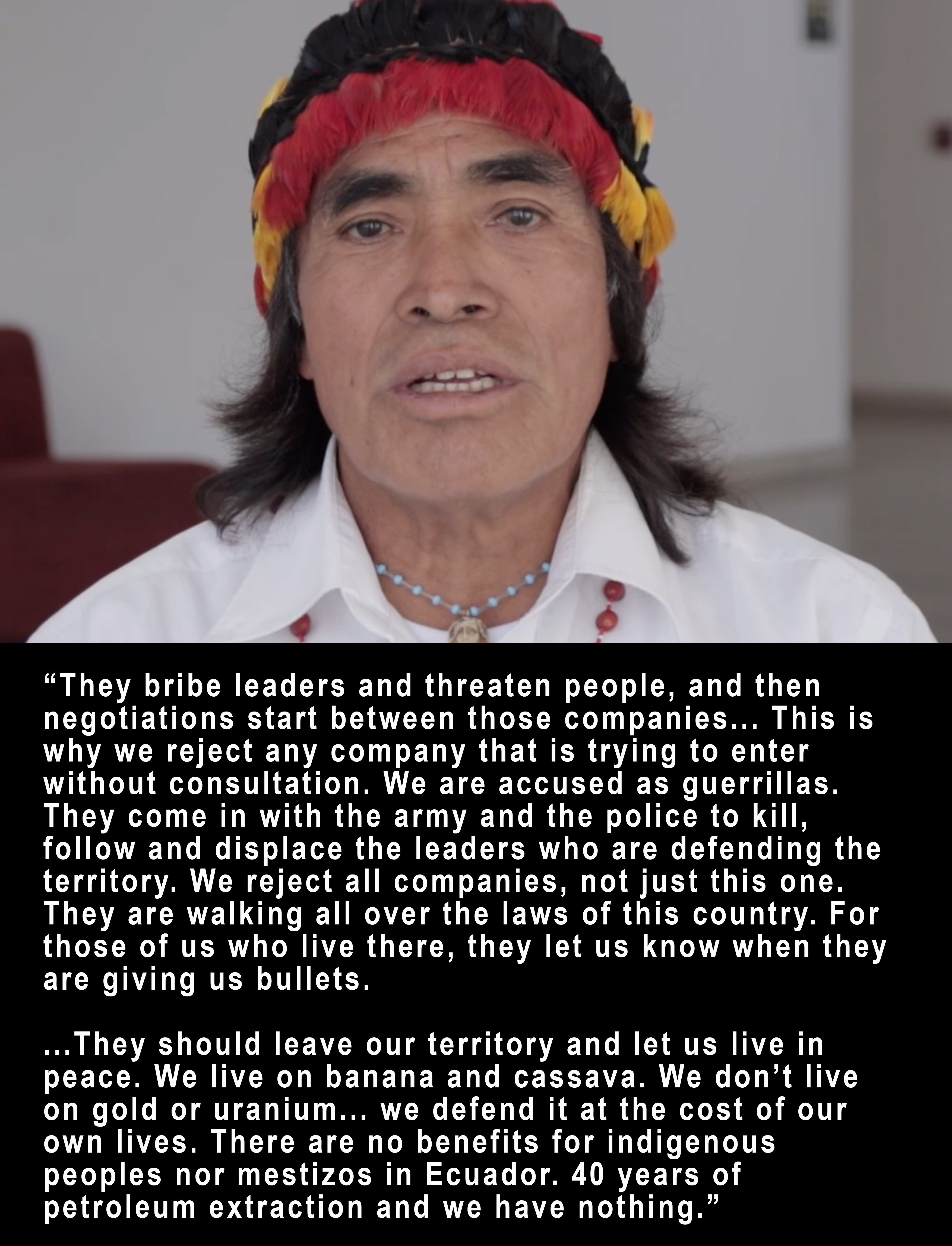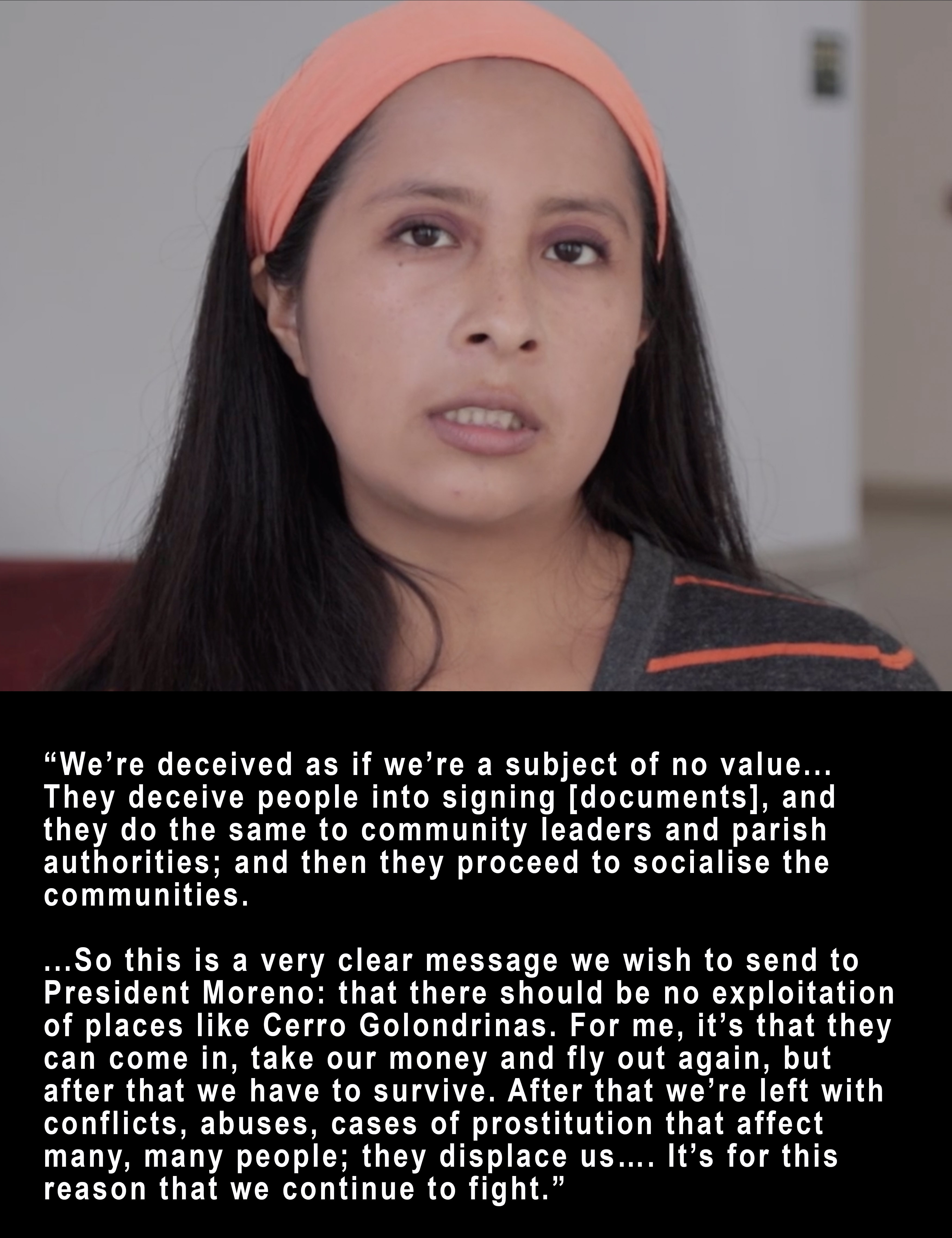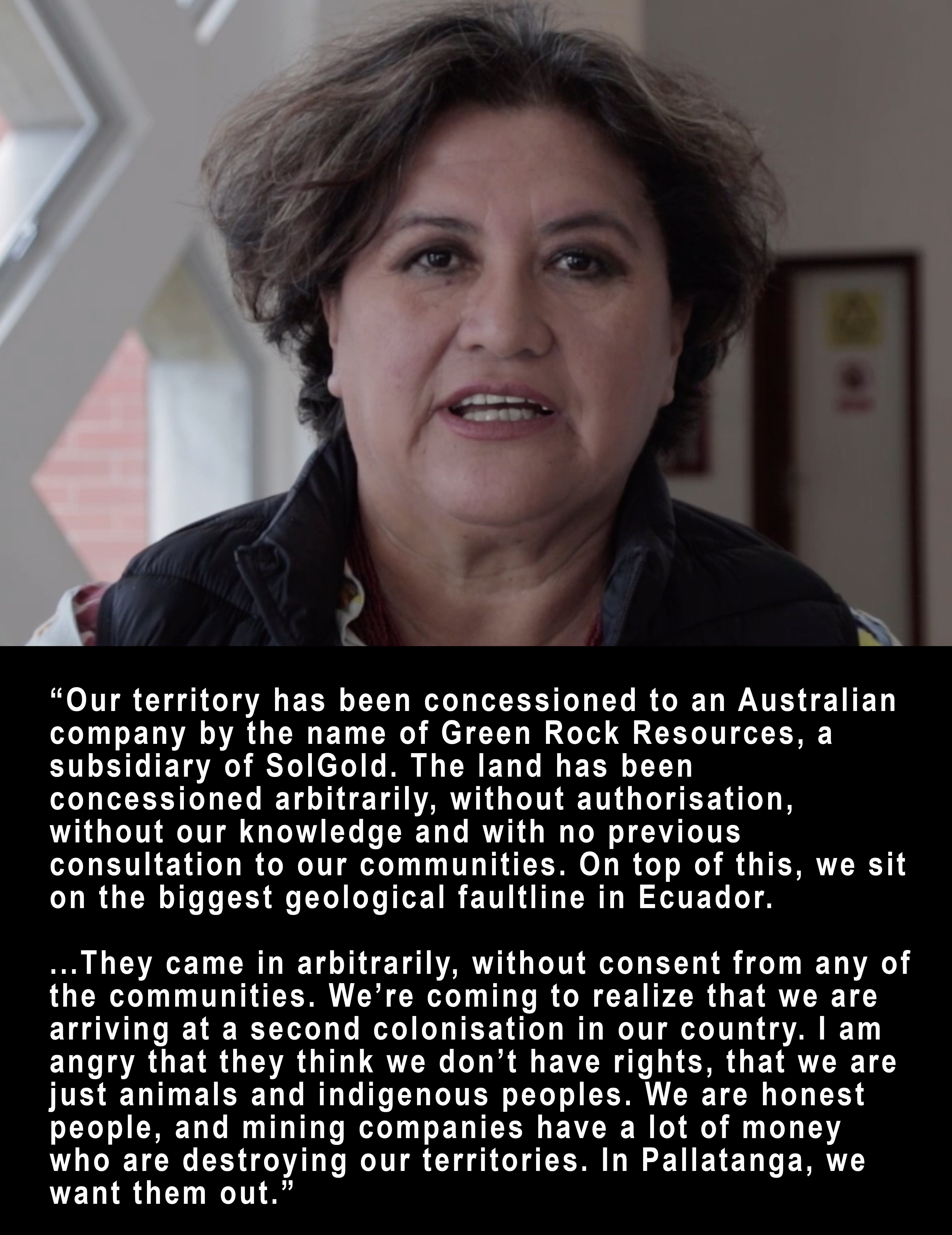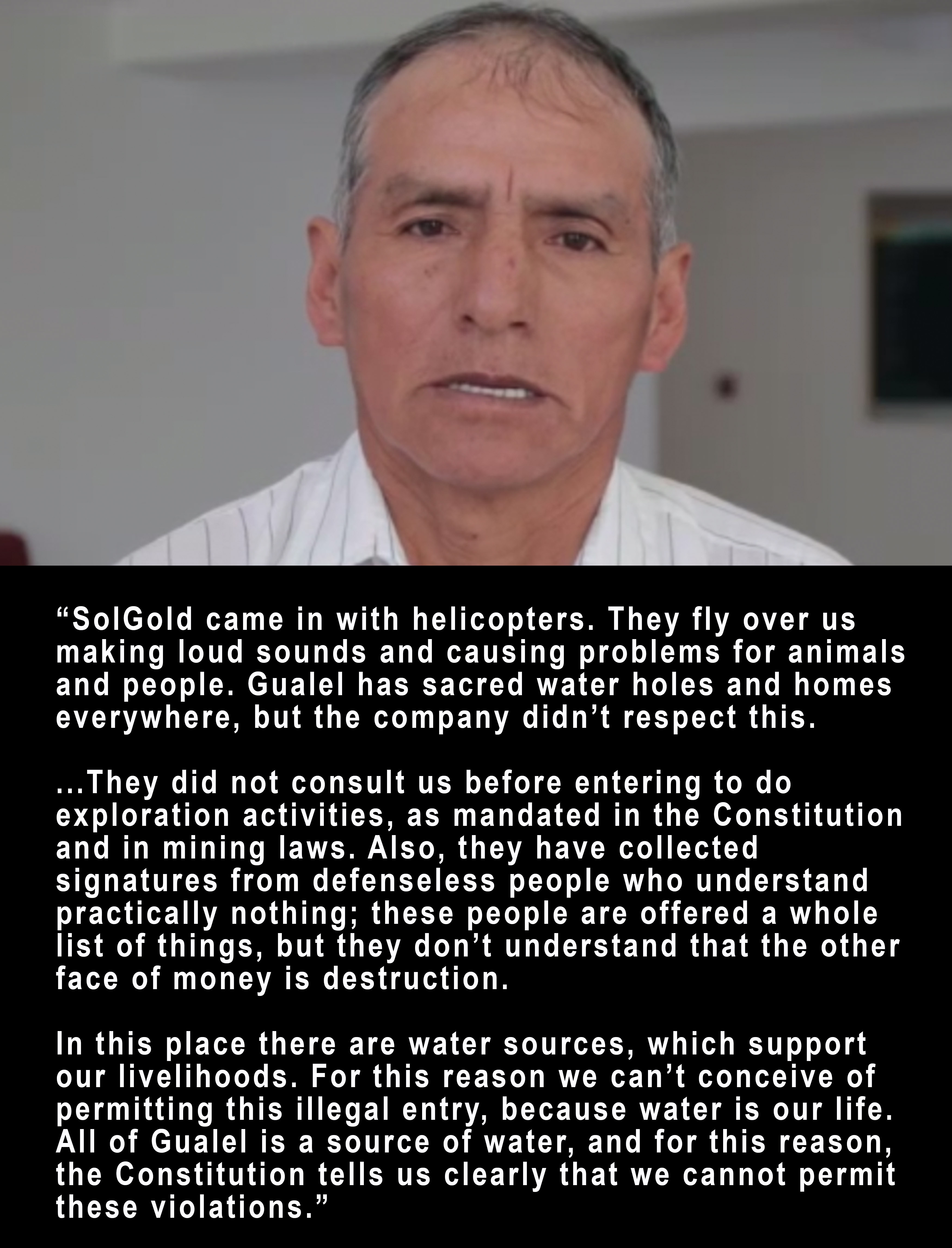SOLGOLD AGM 20 SEPTEMBER 2019
Members of the Rainforest Action Group attempted to raise their concerns about investing in Ecuador at the SolGold AGM in September 2019 as we believe SolGold has not been transparent with shareholders as to the nature of their concessions. Below are our questions and concerns.
We are concerned that correct consultation processes have not taken place, especially given the Ecuadorian constitution which requires prior and informed consent by communities, and which enshrines the rights of nature and Indigenous people in the constitution. This is particularly important given recent legal wins, for example in April 2019 where the Waorani won a landmark case protecting their land from oil concessions, and in the case of Rio Blanco last year, where the Chinese-owned mine was forced to close over claims communities were not consulted about mining on their land. A case won in the Provincial Court of Imbabura in June barred BHP/Codelco from entering concessions at the Manduriacu Reserve without permission.
What does SolGold say about statements that say authorisation has been falsified and communities have not been consulted? What does SolGold say about territories that have been entered illegally, or explored without permission by SolGold employees? What does SolGold say about permissions being falsified or been obtained with force or coercion, or obtained from someone who does not live in the area? What does SolGold say about aerial magnetic explorations that took place without consent or authorisation of the community?
Security issues
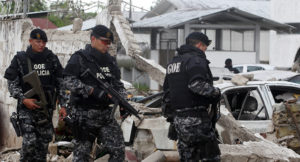
In August 2019, guerrillas from the Revolutionary Armed Forces of Colombia (FARC) announced that the 2016 peace deal had failed and armed revolution was re-established in Colombia. The criminal group has been spreading its actions down into Ecuador ever since the deal was established in 2016.
Cascabel is located in close proximity to the Colombian/Ecuadorian border, an area the Australian Department of Foreign Affairs and Trade (DFAT) advises as a DO NOT TRAVEL area, where regular travel insurance policies are void and the Australian Government says it is unlikely to be able to provide consular assistance. The Cascabel mining site at Alpala is ~10km from this zone, with entry into proposed mining through Roca Fuerte almost on the boundary of the DO NOT TRAVEL zone.
In its 2019 Preliminary Economic Assessment, SolGold suggested that mining material will be transported via pipeline, 60 km north-west towards San Lorenzo. This route goes through an area of significant risk where organised militia with links to FARC conducted a number of bombings in 2018. The police station at San Lorenzo was car bombed in January 2018. A trap bomb loaded with shrapnel killed three and wounded eleven Ecuadorian marines on 19 March 2018. A few weeks later, a second car bomb exploded under a police car.
In April, three journalists were found murdered by dissidents, a bridge was bombed near Viche, and several bombs were placed in transmission towers. As a result, the President of Ecuador, Lenin Moreno, declared a limited State of Emergency in the cities of San Lorenzo and Eloy Alfaro to enhance police and military authority. There were also attacks on civilians and military patrols at the border town of Mataje – now a ghost town with civilians fleeing the embattled area.
This is the area that SolGold have proposed as a route for the pipeline. How will SolGold protect 60 kilometres of pipeline carrying valuable mineralised ore in such dangerous terrain?
SolGold has suggested power for the mine will partially come from Colombia. Both FARC and Colombia’s National Liberation Army (ELN) have targeted energy infrastructure inside Colombia over the years. Up to April 2019 there were about 20 attacks on Colombian pipelines in 2019. The 485-mile (780-km) Cano Limon pipeline was offline for most of 2018 because of more than 80 bombings. How will SolGold safeguard electricity coming from Colombia?
SolGold states in the PEA that workers at Alpala will be bussed in each day from Ibarra. This means that the Alpala mine site itself will have few people staying at the mine overnight except security staff. Given the precarious location of the mine, it is apparent that the mine could become a magnet for criminal groups and armed militia in the region.
We are concerned that not only will the mine be built in a politically unstable and dangerous region, but the pipeline and mining infrastructure, could come under attack or be sabotaged, as could the mine itself. How does SolGold plan to protect such a risky investment?
SolGold has employed the services of security firm G4S to look after its Cascabel security.[1] G4S is facing a raft of lawsuits from staff who have alleged they were forced to work in unsafe conditions on Manus Island, among other places, with security guard Gregory Wisely alleging that after suffering a head injury during a riot, G4S did not allow him to stop work, and that he was not provided with any equipment to radio for help. Documents from a separate legal case allege G4S employed “incompetent and malicious security staff, who escalated the violence at the premises during the riots and contributed to the death of one transferee and the injury to other transferees”. The killed man was asylum seeker Reza Barati.
Can SolGold assure us that G4S will not put staff in similar danger at Cascabel if there is to be an altercation with illegal miners, criminal gangs or armed militia? Can SolGold ensure that G4S will not employ ex-FARC militia, individuals or groups with links to cartels, or guards with military training who might exacerbate the situation at Cascabel? Are G4S responsible for SolGold’s security across Ecuador, or will military or police be used at other concessions? What will the security costs be for all 72 concessions?
[1] Anna Legge, Public Relations for Solgold told us that SolGold was using G4S at Cascabel at the 2019 Prospectors & Developers Association of Canada (PDAC) 3 March 2019.
Illegal mining
Illegal mining in close proximity to the Cascabel concession has occurred at El Cielito (approx. 5-10km north of Cascabel) between 2017 and 2019; and the largest illegal mining operation in Ecuador in almost 30 years, occurred on a mining concession called Imba 2, owned by Australian mining magnate Gina Rinehart. The illegal mine, called El Triunfo, is only 10km south of Alpala. At this location over 10,000 illegal miners operated between November 2017 and July 2019. The miners were eventually evicted after the Moreno Government sent in 2000 troops and hundreds of police officers, however miners are starting to return to the area. Gina Rinehart and the Ecuadorian government are now purportedly in negotiations over who pays for the involvement of the military, with the Government saying it is the responsibility of mining companies to pay for security on their concessions.
How is SolGold safeguarding its concessions from illegal miners? What do you plan to do if a gold rush occurs at Alpala or its other concessions? How will SolGold afford to evict thousands of miners off its concessions in these instances, when there is already so many other factors that are delaying mining at the site?
SolGold’s links to Ecuadorian Military Pension Funds through BHP
In March 2019, BHP signed a US$82M Non-Binding LOI with Luminex Resources for the Condor Project in the south-west of Ecuador, located 55 km south of Ecuacorriente’s Mirador mine and 31 km south of Lundin Gold-Newcrest’s Fruta del Norte mine. Key elements of the deal give BHP the right to earn up to 70% ownership interest by investing an aggregate amount up to US$75M, with BHP making cash payments to Luminex up to US$7M.
The Condor Project is 10%[2] owned by the Instituto de Seguridad Social de las Fuerzas Armadas ("ISSFA"), which is the pension fund for Ecuador's armed forces personnel.
On 5th August 2019, the local Shuar community held a non-violent protest against the Luminex/BHP Tarqui project. The military coincidentally turned up at the same time to conduct a “gun control operation”.
"First the police came. They left after talking to people and seeing that it was peaceful action. Now the army arrives saying they want to do a gun control. #noalamineria #fueradelostitulosglobales #consultaprevia " Tarimiat on Twitter.
What does SolGold think about the ethics of one of their key investors being involved with the Ecuadorian military? Seeing as BHP is a major investor in SolGold can we expect the military to coincidentally turn up when communities protest against other SolGold, BHP and Liminex projects? Or does the military only protect Luminex projects?
[2] Luminex’s level of ownership on the Condor concessions varies between 90% and 100%; 6,900 ha of the 10,101 ha are 90% owned by Luminex.
Environmental impact
In Pallatango, Chimborazo, the Chillanes concession is on top of the biggest geological faultline in Ecuador. The Pallatanga fault (PF) is a prominent NNE-SSW strike-slip fault crossing Central Ecuador. This structure is suspected to have hosted large earthquakes, including the 1797 Riobamba event which caused severe destructions to buildings and a heavy death toll of more than 12,000 people, as well as widespread secondary effects like landsliding, liquefaction and surface cracking.
A mine in the region would be extremely unsafe and a tailings dams in the area at risk of collapse were an earthquake to occur. What will SolGold do to ensure the safety of mines and tailings facilities in this area, and how will SolGold protect local communities from harm if earthquake damage to a mine impacts water sources or causes a threat to life?
Most of southern Ecuador’s cities and towns are already experiencing growing water shortages due to rapid population growth. In Gualel, where there are major water sources, locals are concerned about water contamination by mining activity. These sources not only provide water for the region but are considered sacred. Mining in this area could endanger both their livelihood and their way of life. What is SolGold planning to do to combat any risk to water? What will SolGold do in Bolívar to safeguard both communities access to water, and contamination of these sources? How will SolGold protect against the impact on forest and wildlife in the region?
Cascabel
How deep are the ore deposits at Cascabel? Previous studies indicate they are located at around 2000 metres but this is not being reported to shareholders. A mine 2 kilometres deep in an area of high rainfall and earthquake risk is likely to have significant impact and risk. The depth would also complicate extraction of the ore, and the cost of mining in the area. We are concerned that SolGold does not have the capital to build such a mine, particularly when it has so many other priority projects on the go. Will SolGold sell off Cascabel to another company? What will the impact be on SolGold shareholders if this is the case?
The Cascabel concession is part of the Mira River basin, and is surrounded by mature primary and secondary forests that house endangered species, and protect pristine microbasins. The entire Cascabel concession is part of the catchment for the Mira River which then runs through Colombia. Any contaminants that put this river system at risk could cause an international incident.
We are concerned about the impacts of the mine and related infrastructure on the local ecosystem, as well as the toxic waste generated by mining activities.
SolGold itself has said that it will extract 2.4 billion tonnes of ore from the mine. Based on that figure, we estimate the tailings generated by this mine would amount to at least 1km3 (1,000,000,000 m3), and could possibly exceed 2km3 over the life of the mine. To put these figures in perspective, the capacity of the largest lake in Ecuador – Lake Quilotoa is 0.35km3, making tailings produced enough to fill the lake three times over, at a conservative estimate.
In their preliminary reports, SolGold states that decisions regarding the management of tailings are still in preparation. Can SolGold guarantee that the mined rocks do not contain pyrites or monosulphides, and can you guarantee that SolGold/ENSA will maintain tailings dams in the Cascabel concession for hundreds of years to ensure the toxicity of this waste is safely contained?
Given that the mine is in an area of high rainfall and earthquake risk, can SolGold guarantee that the structure of tailings dams built on the Cascabel concession will be sound and will not be vulnerable to earthquakes, overflow from heavy rain or increased waste volumes, as occurred with the Vale/BHP disaster in Bento Rodrigues in November 2015, or that of Brumadihno, where 300 Brazilians died when the tailings pool collapsed in January 2019? We understand that SolGold have very limited experience in mine construction. The approval of a record-height tailings dam at Mirador leaves us highly concerned that similar foolhardy constructions will be approved at Cascabel.
We are concerned that Alpala will not be the only mine constructed in the Cascabel concession. From SolGold’s reports, we are given to understand that there are several other ore bodies that ENSA/SolGold are exploring within the concession. Can SolGold disclose if this is the case, and if these ore bodies will be block cave mined individually, or absorbed into one large supermine several kilometres in size?
MRAG gathered testimonials from Indigenous and campesino communities in Ecuador who claim that SolGold are exploring illegally on protected forests or indigenous lands, and have falsified authorisations. They say that SolGold has “no social license, have done almost no socialisation, and have done no consultation whatsoever”.
TESTIMONIES FROM COMMUNITIES IMPACTED BY SOLGOLD OPERATIONS
